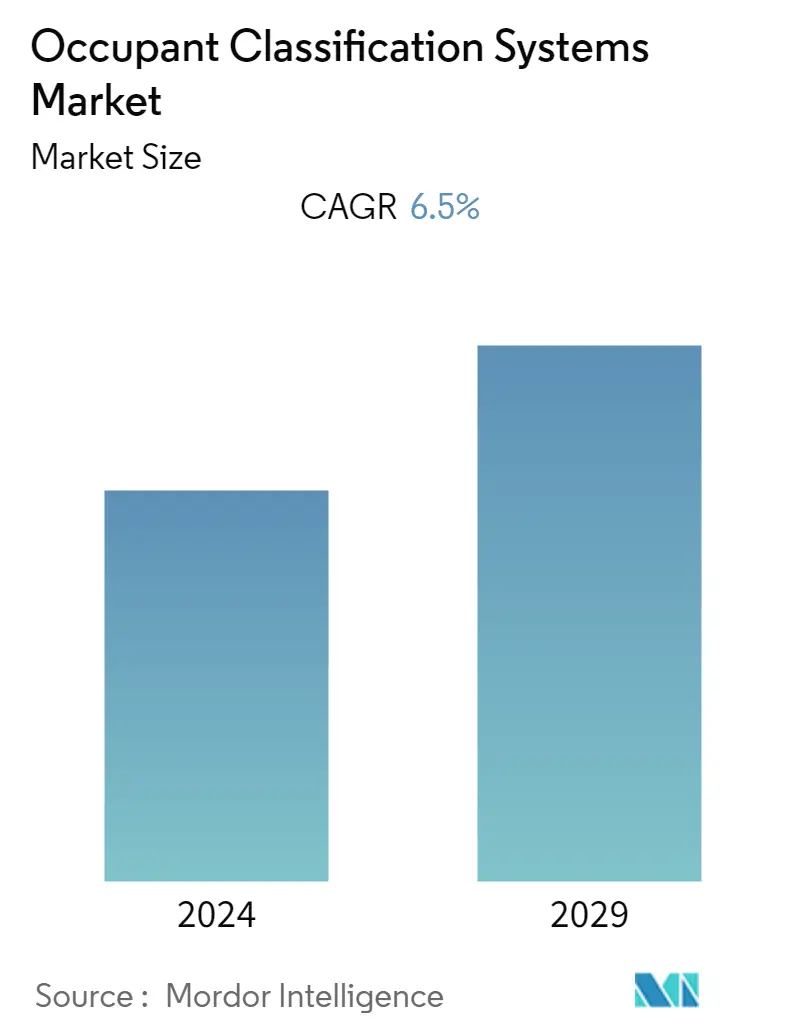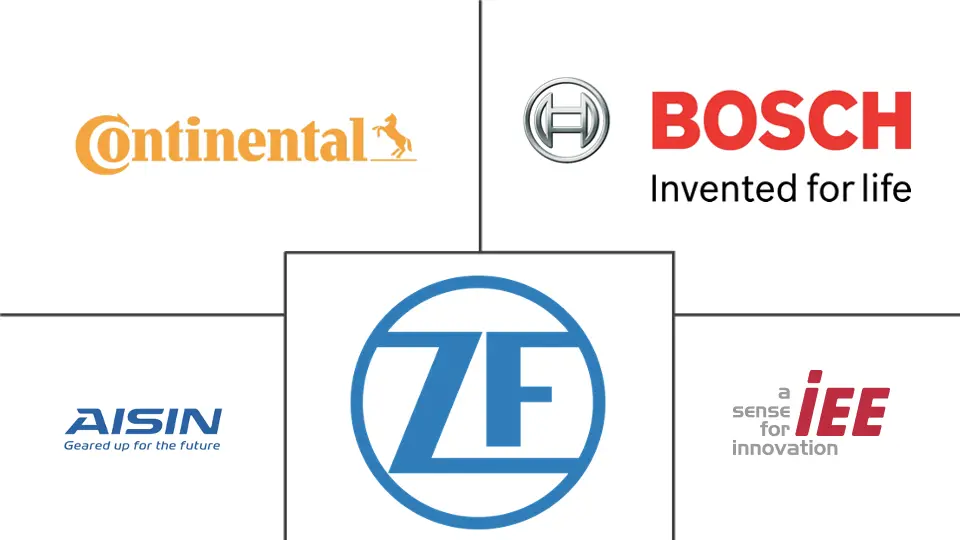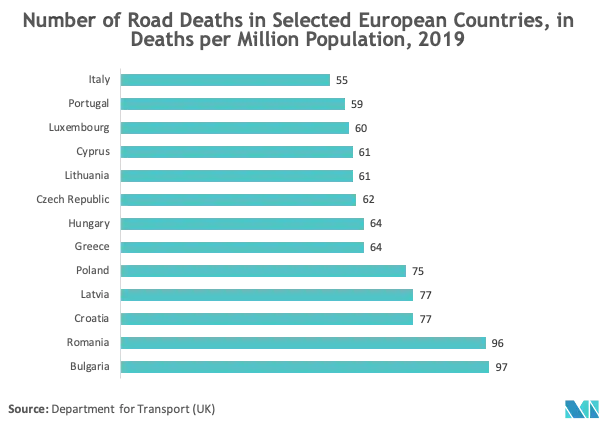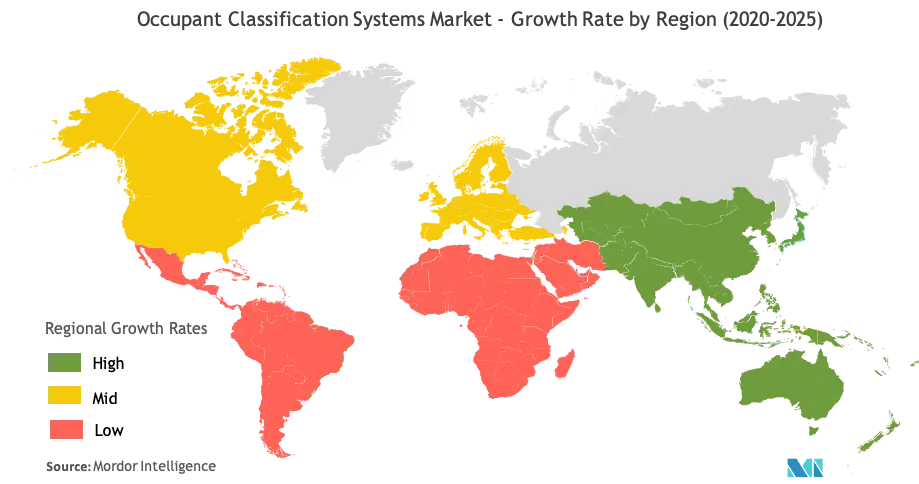Occupant Classification Systems Market Size

| Study Period | 2019 - 2029 |
| Base Year For Estimation | 2023 |
| CAGR | 6.50 % |
| Fastest Growing Market | Asia Pacific |
| Largest Market | North America |
| Market Concentration | Low |
Major Players
*Disclaimer: Major Players sorted in no particular order |
Occupant Classification Systems Market Analysis
The occupant classification systems (OCS) market is expected to witness a CAGR of 6.5% during the forecast period (2021 - 2026). OCS detects the existence and physique of the passenger seat occupant for the Advanced Air Bag requirements. This system distinguishes between gender, as well as children and adults, by their seating postures with the help of pressure sensors in the seat and tension on seat belts.
- The increasing demand for safety in automobiles is boosting the market's growth positively. For instance, according to the World Health Organization, globally, approximately 1.35 million people are killed in road accidents every year. Moreover, between 20 and 50 million more people suffer non-fatal injuries, with many incurring a disability as the result of their injury. OCS plays an important role in improving the safety features of vehicles.
- Additionally, the rising automotive sales and increasing production of autonomous vehicles worldwide are fueling the demand for inertial systems in the automotive industry. According to the OICA (Organisation Internationale des Constructeurs d'Automobiles), the sales of automotive worldwide, in 2019, reached 95 million units. Moreover, according to UBS, the global market for sensor semiconductor autonomous vehicles is expected to reach USD 30 billion by 2030. Such high growth in automotive sales is expected to further drive the demand for OCS in the forecast period.
- Asian countries, such as China, India, South Korea, Taiwan, Japan, who have a significant presence of manufacturers of the OCS, as well as the highest automotive market has experienced lockdown and have impacted the production schedules. The sales have been down as the lockdown in most of the global economies has been resulted in deliveries limited to essentials and has resulted in companies revising their revenue targets.
Occupant Classification Systems Market Trends
This section covers the major market trends shaping the Occupant Classification Systems Market according to our research experts:
Passenger Safety and security Regulations and Increased Focus on Compliances to Drive the Market
- The 2030 Agenda for Sustainable Development has set a target for halving the global number of deaths and injuries from road traffic crashes by 2020. Moreover, increasing awareness about the safety of drivers, the increasing influence of safety regulations imposed by the US Department of Transportation, and the European Union are expected to create opportunities for the market. Mandated safety systems, such as electronic stability control (ESC), attained full implementation in new vehicles in major automotive markets. For instance, the United States is currently driving the growth for MEMS accelerometers.
- In March 2019, the European Commission announced a revision of the General Safety Regulations to make autonomous safety technologies a mandatory requirement for vehicles manufactured in Europe, in a bid to bring down accident levels in the region. Stringent regulations are pushing the automotive vendors to implement the latest sensor-based systems. This is creating opportunities for the market.
- Electronic safety systems in the automotive industry have increasingly-stringent requirements. The functional Safety Standard ISO26262 applicable in the automotive industry requires it to ensure that automated systems in cars are safe.

Europe to Witness a Significant Market Growth
- The European automotive sector has ascended to the top of the global industry. It has achieved record sales, and as a major employer and a source of significant grantmaking, it is an integral part of European society. Over the last few decades, the automotive industry in the United Kingdom has been completely transformed. Every 20 seconds, a car, van, bus, or truck rolls off a UK production line. Over 80% of these are exported to more than 100 countries. In the first eleven months of 2019, a total of 2,223,058 passenger cars were sold in Europe, according to the Society of Motor Manufacturers and Traders (SMMT).
- Every year thousands of people lose their life or are seriously injured in accidents on the EU roads. Between 2001 and 2017, the number of road deaths in Europe decreased by 57.5%. Of the total number of fatalities, 46% is accounted for cars and commercial vehicles. Owing to the deaths caused by road fatalities, most of the automobile manufacturers are deploying inertial systems that enhance rider safety.
- Moreover, these fatalities and deaths have also influenced government organizations and institutions to set up strict regulations for the deployment of advanced technology. For instance, the EU institutions have reached a provisional political agreement on the revised General Safety Regulation. As of 2022, new safety technologies will become mandatory in European vehicles to protect passengers, pedestrians, and cyclists.
- The European Commission expects that the proposed measures will help save over 25,000 lives and avoid at least 140,000 serious injuries by 2038. This will contribute to the EU’s long-term goal of moving close to zero fatalities and serious injuries by 2050 (“Vision Zero”). Such regulations are anticipated to boost the market for automotive inertial systems in the region.

Occupant Classification Systems Industry Overview
The market for the occupant classification system is highly competitive. The brand identity associated with the companies has a major influence on this market. As strong brands are considered to be synonymous with good performance, long-standing players are expected to have the upper hand. Some of them are IEE Sensing, Continental AG, and Robert Bosch GmbH. Considering their market penetration, and the ability to invest in new technologies, the competitive rivalry is expected to continue to be high.
- In September 2019 - Measurement Specialties Inc., a subsidiary of TE Connectivity Ltd, had completed the previously announced acquisition of Silicon Microstructures Inc. from Elmos Semiconductor AG. SMI's micro-electro-mechanical systems (MEMS) sensor technology design and manufacturing capabilities, with TE's operational scale, customer base, and existing sensors technologies, lead to more comprehensive global sensing solutions offering for customers. SMI expands TE's global leadership in pressure sensing technology, particularly in medical, transportation, and industrial applications
- In March 2019 - Bosch opened its new 'Connectory' in London as an incubator for urban mobility solutions. The company says the Shoreditch-based location is open to partners from the public, private, and academic sectors, from start-ups to multinational organizations with a dedicated goal, 'to develop smart mobility solutions for London.'
Occupant Classification Systems Market Leaders
-
ZF Group
-
Continental AG
-
Aisin Seiki Co Ltd
-
Robert Bosch GmbH
-
IEE SENSING
*Disclaimer: Major Players sorted in no particular order

Occupant Classification Systems Market Report - Table of Contents
1. INTRODUCTION
- 1.1 Study Assumptions and Market Definition
- 1.2 Scope of the Study
2. RESEARCH METHODOLOGY
3. EXECUTIVE SUMMARY
4. MARKET DYNAMICS
- 4.1 Market Overview
-
4.2 Market Drivers
- 4.2.1 Emergence of MEMS Technology
- 4.2.2 Passenger Safety and Security Regulations and Increased Focus on compliance
-
4.3 Market Restraints
- 4.3.1 Integration Drift Error
- 4.4 Industry Value Chain Analysis
-
4.5 Porter's Five Forces Analysis
- 4.5.1 Threat of New Entrants
- 4.5.2 Bargaining Power of Buyers/Consumers
- 4.5.3 Bargaining Power of Suppliers
- 4.5.4 Threat of Substitute Products
- 4.5.5 Intensity of Competitive Rivalry
- 4.6 Assessment on the Impact of COVID-19 on the market
5. EMERGING TECHNOLOGY TRENDS
6. MARKET SEGMENTATION
-
6.1 By Component
- 6.1.1 Airbag Control Unit (ACU)
- 6.1.2 Sensors
- 6.1.2.1 Pressure Sensor
- 6.1.2.2 Seat Belt Tension Sensor
-
6.2 By Vehicle Type
- 6.2.1 Light Vehicles
- 6.2.2 Electric Vehicles
-
6.3 Geography
- 6.3.1 North America
- 6.3.2 Europe
- 6.3.3 Asia-Pacific
- 6.3.4 Latin America
- 6.3.5 Middle East & Africa
7. COMPETITIVE LANDSCAPE
-
7.1 Company Profiles
- 7.1.1 ZF Group
- 7.1.2 Continental AG
- 7.1.3 Aisin Seiki Co. Ltd
- 7.1.4 Robert Bosch GmbH
- 7.1.5 IEE SENSING
- 7.1.6 Aptiv Corporation
- 7.1.7 Denso Corporation
- 7.1.8 Autoliv Inc.
- 7.1.9 TE Connectivity Limited
- 7.1.10 ON Semiconductor Corporation
- *List Not Exhaustive
8. INVESTMENT ANALYSIS
9. MARKET OPPORTUNITIES AND FUTURE TRENDS
** Subject To AvailablityOccupant Classification Systems Industry Segmentation
The study of the occupant classification systems (OCS) market has considered the various offerings from the vendors for sensors and airbag systems, globally. The OCS systems enable the differentiation of passenger seating on the front passenger seat to assist advanced airbag safety systems.
| By Component | Airbag Control Unit (ACU) | |
| Sensors | Pressure Sensor | |
| Seat Belt Tension Sensor | ||
| By Vehicle Type | Light Vehicles | |
| Electric Vehicles | ||
| Geography | North America | |
| Europe | ||
| Asia-Pacific | ||
| Latin America | ||
| Middle East & Africa |
Occupant Classification Systems Market Research FAQs
What is the current Occupant Classification Systems Market size?
The Occupant Classification Systems Market is projected to register a CAGR of 6.5% during the forecast period (2024-2029)
Who are the key players in Occupant Classification Systems Market?
ZF Group, Continental AG, Aisin Seiki Co Ltd, Robert Bosch GmbH and IEE SENSING are the major companies operating in the Occupant Classification Systems Market.
Which is the fastest growing region in Occupant Classification Systems Market?
Asia Pacific is estimated to grow at the highest CAGR over the forecast period (2024-2029).
Which region has the biggest share in Occupant Classification Systems Market?
In 2024, the North America accounts for the largest market share in Occupant Classification Systems Market.
What years does this Occupant Classification Systems Market cover?
The report covers the Occupant Classification Systems Market historical market size for years: 2019, 2020, 2021, 2022 and 2023. The report also forecasts the Occupant Classification Systems Market size for years: 2024, 2025, 2026, 2027, 2028 and 2029.
Enzyme Replacement Therapy Industry Report
Statistics for the 2024 Enzyme Replacement Therapy market share, size and revenue growth rate, created by Mordor Intelligence™ Industry Reports. Enzyme Replacement Therapy analysis includes a market forecast outlook 2029 and historical overview. Get a sample of this industry analysis as a free report PDF download.



